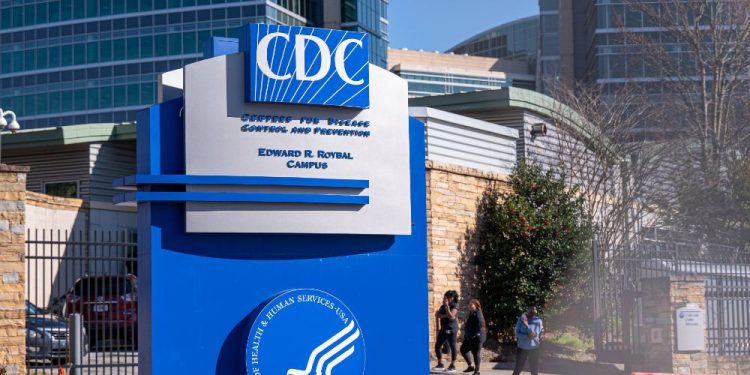(The Epoch Times)—The U.S. Centers for Disease Control and Prevention (CDC) said in a recent update that the new COVID-19 variant JN.1 is continuing to spread across the United States, having nearly doubled in the past two weeks or so.
The agency said on Dec. 22 that JN.1 is continuing “to cause an increasing share of infections and is now the most widely circulating variant in the United States,” adding that it’s now about 39 percent to 50 percent of all COVID-19 variants, whereas JN.1 amounted to about 15 percent to 29 percent two weeks ago.
“JN. 1’s continued growth suggests that the variant is either more transmissible or better at evading our immune systems than other circulating variants. It is too early to know whether or to what extent JN.1 will cause an increase in infections or hospitalizations,” the CDC said. “We’re also seeing an increasing share of infections caused by JN.1 in travelers, wastewater, and most regions around the globe,” it added.
COVID-19 activity across the U.S. is “elevated and increasing” but “not dramatically,” the CDC said. Historical data shows that the current rash of COVID-19 infections across the country is smaller than previous years’ increases.
Days before, the U.N.’s World Health Organization (WHO) listed the COVID-19 sub-variant JN.1 as a “variant of interest,” but it noted there is currently no evidence suggesting it’s more severe or a significant health risk.
Due to “limited evidence” that is currently available, the U.N. agency said that the variant “may cause an increase in SARS-CoV-2 cases amid a surge of infections of other viral and bacterial infections, especially in countries entering the winter season,” referring to the virus that causes COVID-19.
The latest CDC update comes as the agency’s director, Dr. Mandy Cohen, said that people who are sick should “please stay home.” However, she did not repeat the CDC’s recommendations during the pandemic that everyone should stay home regardless of whether they’re sick or not.
“Avoid spreading germs to others, especially your loved ones who are at higher risk of getting very sick. Also, get tested, so you know what you have and can get treatment,” she said on X.
Low Risk?
But despite the classification, WHO says that JN.1 likely poses a low risk compared with other COVID-19 variants.
“The spread of this variant will unlikely increase the burden on national public health systems compared to other Omicron sublineages,” the advisory said. “However, countries approaching the winter season should be aware that, altogether, SARS-CoV-2 and co-circulating pathogens may exacerbate the respiratory disease burden.”
JN.1 is now listed alongside Omicron sub-variants, including BA.2.86, XBB.1.5, XBB.1.16, EG.5, and BA.2.86, which were deemed variants of interest. The U.N. health agency lists variants under several categories: variants under monitoring, which is the lowest level; variants of interest; and variants of concern, or the highest level.
While there might be more cases with the variant, the new variant doesn’t pose a greater risk, Andrew Pekosz, a virologist at the Johns Hopkins Bloomberg School of Public Health, told ABC News last week.
“As we observe the rise of the JN.1 variant, it’s important to note that while it may be spreading more widely, there is currently no significant evidence suggesting it is more severe or that it poses a substantial public health risk,” Dr. John Brownstein, the chief innovation officer at Boston Children’s Hospital, told ABC News.
Meanwhile, the CDC has said there is no evidence that JN.1 causes significantly different symptoms than other COVID-19 variants that are currently circulating. Like with other strains, many people may easily mistake symptoms of a COVID-19 case with other illnesses such as influenza, RSV, or the common cold.
Symptoms of a JN.1 COVID-19 infection could include cough, sore throat, headache, muscle aches, fever, loss of taste or smell, runny nose, brain fog, fatigue, muscle aches, and congestion.






Is this humor???
The CDC is the propaganda front for BIG PHARMA —- when was the CDC ever honest about anything???
Which brainless lying twit is now in charge at CDC — — we keep,getting thwm mixwd up as they look and sound the same?!
Tell the effing CDC to either tell us the lab locations pumping this CUHRAP out or find their lab locations?!?!
Is this a fake news site???
Symptoms of a JN.1 COVID-19 infection could include cough, sore throat, headache, muscle aches, fever, loss of taste or smell, runny nose, brain fog, fatigue, muscle aches, and congestion.
Basically the same symptoms of all sicknesses over the last few hundred years. T